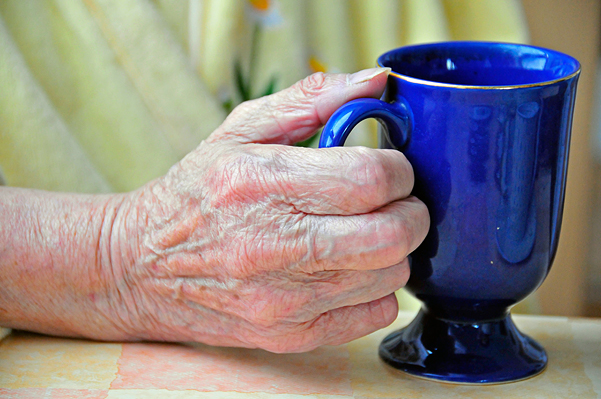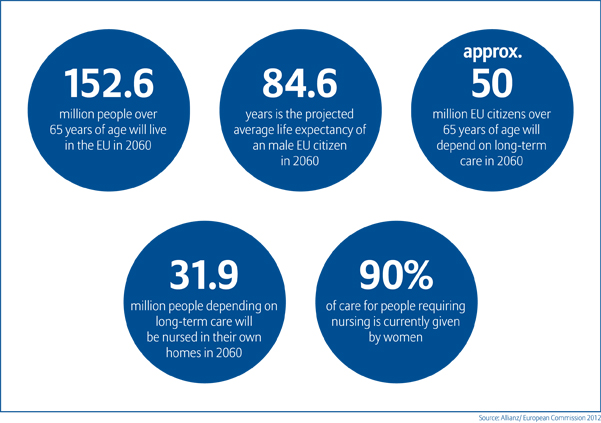Jiroemon Kimura, from Japan, is believed to be the world's oldest man. When he was born in 1897, Queen Victoria was still on the throne in England and Rudolf Diesel was trying out his engine for the first time. Kimura is lucky: he is currently living with his family and is in good health. In future, this situation will become less and less common for elderly people. An increasing number of older people are requiring long-term care. In Germany alone, there are currently over two million people needing care. This is one of the many things that International Long-Term Care day on May 12, 2013 seeks to remind people of. Because people in Germany will live longer in future, experts are estimating that the number of people in need of care will double by 2050. "We estimate that in 2050, around 4.5 million people will be reliant on care. People who want to be well looked after if this situation does arise, will have to rethink their retirement provision", says Allianz expert Klaus Michel.
Long-term care situation is escalating

People who want to be well looked after if this situation does arise, will have to rethink their retirement provision.
Demographic change leads to a society reliant on long-term care
Development across Europe will be following a comparable course. In 2060, around 152 million people living in the EU will be over 65 years old. Of these, over 50 million EU citizens will require long-term care.The average life expectancy of a baby boy will then be almost 85 years, and for a new-born girl this figure will be 89.1 years. This will result in fewer and fewer young people having to care for more and more elderlypeople. "This is an alarming development. The situation is being exacerbated by demographic change, because we're also having to cope with a decreasing workforce in the care sector and the associated increase in the cost of long-term care", says Michel.
Qualified care staff and care homes have become considerably more expensive in recent years. The following statistics illustrate this development:
Even though the statutory pension and the benefits provided by statutory long-term care insurance have increased in the past few years, the increases have not compensated for the raised long-term care costs. For example, in 1999, a 'standard' pension (the pension received by an individual on an average salary after 45 years of work) plus the benefits of statutory long-term care insurance, were enough to finance the monthly cost of a care home for someone assessed as long-term care grade III, of around 2,470 euros.
In the ten years that followed, the cost of a care home increased by around 16 percent, to total an average of 2,865 euros. A standard pension plus the benefits of statutory long-term care insurance are now insufficient to cover the cost of a care home. Since 2009, a gap of around 300 euros per month on average has arisen in the financing of in-patient long-term care for an individual assessed at grade III, which must be assumed by the person requiring the care.
The aforementioned figures can only begin to indicate the problems that those reliant on care and their relatives will face in future. The new concept for provision in the event that long-term care does become necessary, introduced on January 1, 2013, represents one approach to resolving this issue. This concept, known as "Pflege-Bahr", is a state-funded supplementary long-term care insurance product.

A lack of care staff is making the situation worse
Many German families are already struggling to care for relatives themselves. This means that many individuals who are in need of long-term care need to be looked after by third parties. At the same time, there are fewer and fewer people working in the care sector. In Germany, there are currently around 950,000 professional carers who are working alongside family members to look after around 2.5 million people in need of care. Experts are anticipating that in future, by 2060, 783,000 more carers will be required in Germany alone.
The question which really needs to be resolved quickly is where this extra workforce should come from? An exacerbating factor will be the fact that the percentage of the population of working age will simultaneously be reducing in size. High priority should therefore be given to improving the image of the care professions. Klaus Michel commented: "Every person has the right to dignity in their old age and to the corresponding care services. In order to guarantee this, the care sector has to become more attractive as a profession and young people need to be encouraged to look into it as a job."
The majority of carers are female relatives
Nowadays, the burden of long-term care rests primarily on the shoulders of female family members. Individuals in need of care receive 90% of this from female relatives. Many women see themselves facing a double challenge: being professionally successful and simultaneously taking responsibility for caring for relatives at home. Today's society has to reduce the strain on families and facilitate the combination of care and carer. This includes not only flexible working hours, but also the option of taking time out from one's career. "The statutory framework needs to be adapted to what is required: enabling financial protection and simultaneously introducing new provision models. Both these things will be necessary if we want to guarantee an appropriate standard of care in future", says Klaus Michel.
Forward Looking Statement disclaimer
As with all content published on this site, these statements are subject to our Forward Looking Statement disclaimer: